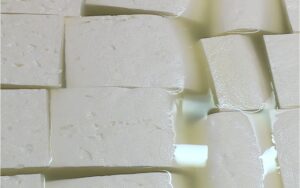
A couple of weeks ago, India’s food regulator, the FSSAI (Food Safety and Standards Authority of India), issued a notification asking food businesses to stop distinguishing milk and milk products as A1 or A2 in their marketing. The reason was simple. It believed that these claims were misleading consumers.
So, what’s going on?
Well, to begin with, the FSSAI’s regulations don’t actually recognise any difference between A1 and A2 milk. If you’re scratching your head wondering what those terms even mean, let’s break it down.
Milk is a great source of protein. And there are two main types of milk protein — whey and casein. Casein has a subtype called beta-casein, which makes up about a third of the total protein in milk. And beta-casein comes in two forms — A1 and A2.
But the reason why the FSSAI doesn’t care about this distinction probably boils down to two things.
First off, most of the milk produced in India is already A2 milk. According to R.S. Sodhi, the former MD of Amul, Indian indigenous cow breeds like Gir, Sahiwal and Tharparkar produce only A2 milk. It was only during the 1970s White Revolution (a.k.a. Operation Flood) that European cow breeds like the Jersey and Holstein Friesian, which produced A1 milk, were crossbred with Indian cows to boost milk production. But crossbred cows still make up a small fraction of India’s total cow population. So, chances are that the milk you’re drinking is already A2, even if it’s not labelled that way.
Second, there’s no solid scientific evidence that A2 milk is actually better for your health than A1.
Sure, a 2012 study titled Milk Proteins and Human Health: The A1/A2 Milk Hypothesis hinted that A1 beta-casein could be linked to health issues like type-1 diabetes, heart disease and even autism. And it also claimed that people who consumed mostly A2 milk seemed less prone to these conditions. But here’s the catch. Global research has since found that most of this research has been based on animal studies and poorly designed clinical trials. In other words, there’s no conclusive proof that A2 milk is better for us.
Then how the heck did all this A2 milk hype even start, you ask?
You can pretty much blame New Zealand for this buzz because that’s where it all began. Thanks to the farming and dairy industry which plays a big role in their economy. In the 1990s though, the dairy market there was saturated with traditional dairy products. And companies needed something new to stand out.
Their answer?
You guessed it… A2 milk!
It all began in 1993 when two New Zealand scientists, Professor Bob Elliott and Dr. Corran McLachlan, found that A1 milk might cause digestive problems and even more severe health issues like Type 1 diabetes and heart disease. They claimed that A2 milk didn’t come with these risks and was easier to digest, even for people who were lactose intolerant.
A few years later, McLachlan partnered with a billionaire farmer Howard Paterson to launch the A2 Milk Company (A2MC). They started marketing A2 milk as a healthier alternative in Australia and New Zealand. And their message gained more popularity when Keith Woodford, a professor at Lincoln University, published a book linking A1 protein to various health issues.
His conclusion? We should all switch to A2 milk.
Now, while the book made waves, there was a catch. Woodford himself apparently had ties with A2MC, raising suspicions about whether the entire A2 milk revolution was just a clever marketing ploy.
But despite these doubts, the idea that A2 milk is healthier stuck with people, largely due to experts who continued to promote it as less problematic than A1 milk.
And this belief has driven up the price of A2-branded milk. To put things in perspective, in India, regular milk (which, by the way, is often already A2) sells for around ₹50-65 per litre. A2-branded milk, on the other hand, can sell for 2-3 times that price.
And it’s not just milk. Even ghee (clarified butter) made from A2 milk commands a massive premium, sometimes costing up to 10 times more than regular ghee. But here’s the kicker. Ghee is 99.99% fat, which means that A1 or A2 protein has no role to play in it. This was confirmed by none other than Amul’s former MD, R.S. Sodhi, who noted that charging extra for A2 ghee seems like a shady marketing tactic.
But then, there’s another side to this entire story.
See, A2-branded milk isn’t expensive just because it’s marketed as a premium product. Many startups selling A2-branded milk also emphasise that they treat their cows ethically. They claim that they only milk the cows after their calves have had their share, and they don’t engage in the mass production practises common with large dairy companies that source from cooperatives.
And if that’s the case, running this kind of business can be pricey, especially with domestic breeds like Gir and Sahiwal, which produce only 5-6 litres of milk a day. In contrast, crossbred cows like the Jersey and Holstein churn out 15-20 litres daily. So, these startups depend on the premium pricing to sustain these ethical, small-scale operations.
And that’s probably what concerns the FSSAI.
Since most milk in India is already A2, the regulator might be worried that companies are slapping the label on their products just to charge more.
But here’s where things get tricky. See, India’s dairy sector is aiming to go global. And according to government data, India is the largest milk producer in the world, accounting for 25% of global production. So, as Indian dairy farmers look to expand exports, having the A2 milk label could give them a competitive edge in the international market, no?
That’s probably why the FSSAI backtracked on its directive. After all, by stopping companies from marketing A2 milk, India might be shooting itself in the foot while trying to increase its credibility on the global dairy stage.
But yeah, we get it — it might sound a bit hypocritical. That’s why the FSSAI has decided to sit down with all the stakeholders and figure out once and for all how they’re going to handle milk branding going forward. And we’ll just have to wait and see how things play out.
Until then…
P.S. You can dig deeper into the A2 milk story on Truth Be Told, The Whole Truth’s food blog. And nope, this isn’t a paid promotion — just a genuine shoutout to some great, well-researched food content.
Don’t forget to share this story on WhatsApp, LinkedIn and X.
Don’t let medical bills break the bank!

Most Indian families are just one major medical bill away from bankruptcy. That’s why having the right health insurance is so important. Whether you’re looking for a new plan or want to review your current one, Ditto’s IRDAI-certified advisors are here to help. Click here to book a FREE call today!





